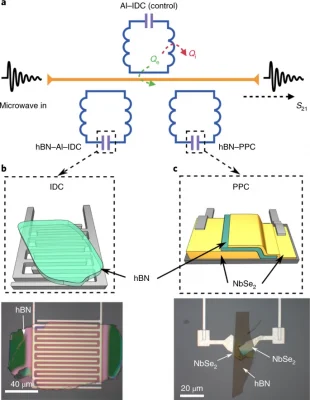Joel I‑J. Wang, Megan A. Yamoah, Qing Li, Amir H. Karamlou, Thao Dinh, Bharath Kannan, Jochen Braumüller, David Kim, Alexander J. Melville, Sarah E. Muschinske, Bethany M. Niedzielski, Kyle Serniak, Youngkyu Sung, Roni Winik, Jonilyn L. Yoder, Mollie E. Schwartz, Kenji Watanabe, Takashi Taniguchi, Terry P. Orlando, Simon Gustavsson, Pablo Jarillo-Herrero & William D. Oliver
DOI: https://doi.org/10.1038/s41563-021–01187‑w
Abstract:
Dielectrics with low loss at microwave frequencies are imperative for high-coherence solid-state quantum computing platforms. Here we study the dielectric loss of hexagonal boron nitride (hBN) thin films in the microwave regime by measuring the quality factor of parallel-plate capacitors (PPCs) made of NbSe2–hBN–NbSe2 heterostructures integrated into superconducting circuits. The extracted microwave loss tangent of hBN is bounded to be at most in the mid-10−6 range in the low-temperature, single-photon regime. We integrate hBN PPCs with aluminium Josephson junctions to realize transmon qubits with coherence times reaching 25 μs, consistent with the hBN loss tangent inferred from resonator measurements. The hBN PPC reduces the qubit feature size by approximately two orders of magnitude compared with conventional all-aluminium coplanar transmons. Our results establish hBN as a promising dielectric for building high-coherence quantum circuits with substantially reduced footprint and with a high energy participation that helps to reduce unwanted qubit cross-talk.

